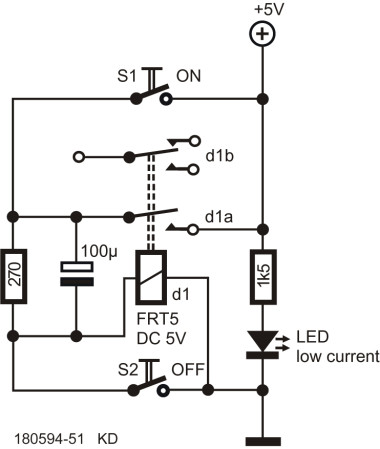Small Circuits Revival (23): Energy-efficient Relay
on
Energy-efficient Relay
idea: Friedrich Lischeck (Germany)
The big disadvantage of the energy-efficient relay that was described in Episode 1 is that it requires pushbuttons with a normally closed (n.c.) contact. These are sometimes difficult to obtain, and most hobbyists are not likely to have these on hand.
The small but clever circuit that we will take a look at now employs normal pushbuttons (i.e. n.o. , normallly open with a momentary contact) and a standard 5-V monostable relay with two (changeover) contacts – see Figure 1.

To make this possible, one of the pair of contacts in the relay is used for this; it is not difficult to figure out the operation of the circuit. The relay coil is energized after pushing S1; both contacts pull in – and the relay coil remains energized via one of the relay contacts and a 270 Ω resistor. Because of the big electrolytic capacitor, which acts as a short circuit at the moment of switch on, the initial energizing current through the relay exceeds the holding current in the energized state.
To switch the relay off it is sufficient to push S2: the relay coil is short-circuited; the relay drops out and the rest state is restored.
The LED indicates whether the circuit is ready to operate. A nice detail is that the relay does not close the instant that the power supply voltage is applied; this does require an actual push on S1. And should someone come up with the idea of pushing both buttons at the same time: not a problem, nothing happens because S2 has priority.


Discussion (6 comments)